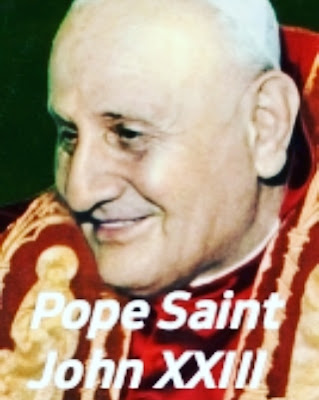October 11 Saint of the Day Profile
October 11 Saint of the Day Profile Pope Saint John XXIII
Profile:
Born to an Italian peasant family. Educated at Bergamo and the
Pontifical Roman Seminary. Ordained on 10 August 1904. Secretary to the
bishop of Bergamo, Italy from 1904 to 1914, during which he wrote the
basis for his five-volume biography of Saint Charles Borromeo. Served in
World War I in the medical corps, and as a chaplain. Worked in Rome,
Italy after the war, and reorganized the Society for the Propagation of
the Faith. Titular archbishop of Areopolis on 3 March 1925. Vatican
diplomatic representative to Bulgaria on 16 October 1931, then to Turkey
and Greece on 12 January 1935. Titular archbishop of Mesembria on 30
November 1934. Papal nuncio to France on 23 December 1944 where he
mediated between conservative and socially radical clergy. Created
cardinal on 12 January 1953, and patriarch of Venice, Italy on 15
January 1953. Elected 261st pope on 28 October 1958.As pope he stressed his own pastoral duties as well as those of other bishops and clergy. Promoted social reforms for workers, poor people, orphans, and the outcast. He advanced cooperation with other faiths and traditions including Protestant, Greek Orthodox, Church of England, and even Shinto. In April 1959 he forbade Catholics to vote for parties supporting Communism. His encyclical, Mater et Magistra of 14 July 1961 advocated social reform, assistance to underdeveloped countries, a living wage for all workers, and support for socialist measures that promised real benefit to society.
He nearly doubled the number of cardinals, making the college the largest in history. On 25 January 1959, he announced his intent to call a council to consider ways to renew the Church in the modern world, promote diversity within the unity of the Church, and consider reforms promoted by ecumenical and liturgical movements. Convening the council, known as Vatican II, on 11 October 1962, was the high point of his reign.
His heartiness, his overflowing love for humanity individually and collectively, and his freshness of approach to ecclesiastical affairs made John one of the best-loved popes of modern times.
Born
25 November 1881 at Sotto il Monte, diocese of Bergamo, Italy as Angelo Giuseppe Roncalli
Papal Ascension
• elected 28 October 1958• installed on 4 November 1958
Died
• 7:50pm on 3 June 1963 at Rome, Italy of stomach cancer• buried in Saint Peter's basilica, Vatican City
Canonized
• on 5 July 2013, Pope Francis approved the promulgation of a decree of canonization• 27 April 2014 by Pope Francis
Patronage
papal delegates
Readings
Everyone remembers the image of Pope John's smiling face and two
outstretched arms embracing the whole world. How many people were won
over by his simplicity of heart, combined with a broad experience of
people and things! The breath of newness he brought certainly did not
concern doctrine, but rather the way to explain it; his style of
speaking and acting was new, as was his friendly approach to ordinary
people and to the powerful of the world. It was in this spirit that he
called the Second Vatican Ecumenical Council, thereby turning a new page
in the Church's history Christians heard themselves called to proclaim
the Gospel with renewed courage and greater attentiveness to the "signs"
of the times. The Council was a truly prophetic insight of this elderly
Pontiff who, even amid many difficulties, opened a season of hope for
Christians and for humanity. In the last moments of his earthly life, he
entrusted his testament to the Church: "What counts the most in life is
blessed Jesus Christ, his holy Church, his Gospel, truth and goodness".
- Pope John Paul II#SaintOfTheDay
#SaintOfTheDayProfile
#SayingsOfTheSaints
#FridayWithTheSaints
#PopeSaintJohnXXIII

No comments:
Post a Comment